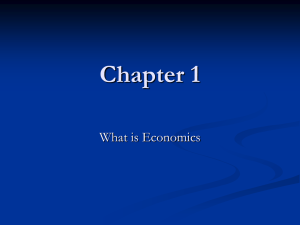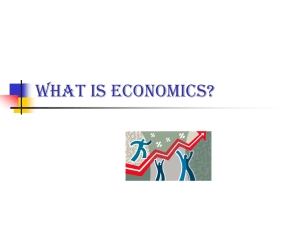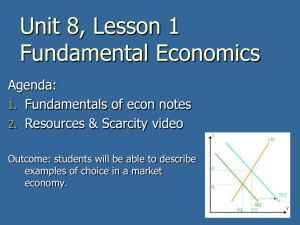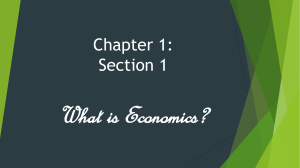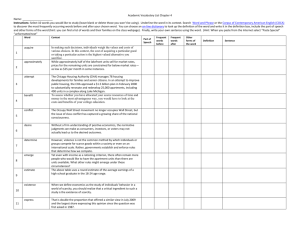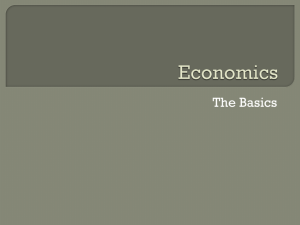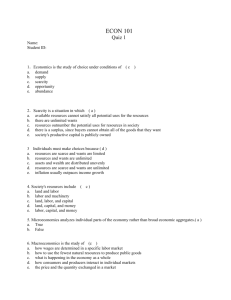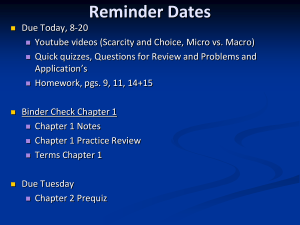Choice & Economics
advertisement
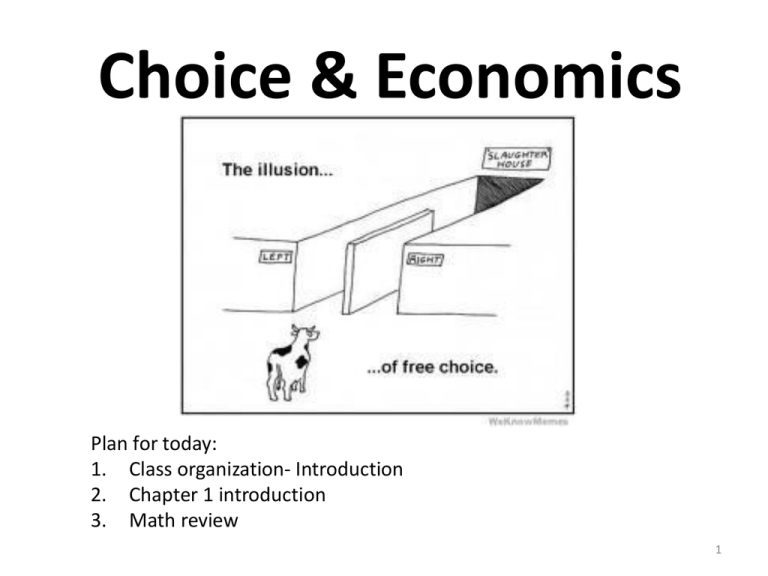
Choice & Economics Plan for today: 1. Class organization- Introduction 2. Chapter 1 introduction 3. Math review 1 "the purpose of studying economics is not to acquire a set of ready-made answers to economic questions, but to learn how to avoid being deceived by economists." Joan Robinson 2 Economics Study of the choices people make to attain their goals given their scarce resources. 1. What do economists study? • gasoline prices, inflation, housing markets, international trade, income inequality, sports, families, smoking, health care, happiness • decision-making or choices 2. How do they do it? • by using theories and models • theories are based on assumptions 3 Resources What is a Resource? Resources are anything that can be used to produce stuff! Land Labor Capital Human Capital 4 Individual Choices Basic Principles Behind Individual Choices: 1. Resources are scarce. 2. The real cost of something is what you must give up to get it. 3. “How much?” is a decision at the margin. 4. People usually take advantage of opportunities to make themselves better off. 5 1. Scarcity • Recall that goods only have economic value if they are scarce. • Without scarcity you wouldn’t have to make a choice. i.e. no costs • Individual decisions vs. “societal decisions” 6 2. Opportunity Costs • Because of scarcity all choices involve trade-offs • The real cost of something is what you must give up to get it. • “The most valuable forgone alternative…” i.e. get a job or go to college? 7 3. Decisions at the Margin • “How Much” is a decision at the margin. Study Time vs. Xbox Eating Donuts • Marginal Analysis: Comparing the costs and benefits of doing a little bit more of less of something 8 Economics Scarcity When the price is zero there is not enough for everyone Unlimited wants Choices People behave as if they are comparing the costs and benefits Benefits Limited availability Costs 9 Economics Scarcity Everything has alternative uses Tradeoffs Opportunity cost 10 Economics Choices People are rational when they behave as if they were comparing costs and benefits People respond to incentives Decisions are made on the margin 11 4. Exploit Opportunities • Everyone wants to be better off! • Incentives: What motivates people to act or change their actions Change Behavior Change Incentives 12 Making Choices • Because of higher gas prices, people in Europe drive smaller cars. Opportunity to make themselves better-off • You are weighing the advantages of working more hours this month. Decision at the Margin Scarce Resources of Time 13 Making Choices • Mothers (Fathers) of young children must weigh returning to work or staying at home with their kids. People face trade-offs • You decide four classes is enough for this semester and not five. Make a Decision at the Margin 14 Example • Should Apple produce an additional 300,000 iPods? • In solving this problem note • Optimal Decisions are made at the margin • An activity should be continued until the marginal benefit is equal to the marginal cost. • Decisions require perfect information about additional revenue and additional costs. 15 Exercise for Chapter 1 • Dell Laptops 16 Microeconomics vs. Macroeconomics • Economic models can be used to analyze decision making in many areas whether it is micro or macro oriented. • Microeconomics- study of how households and firms make choices, how they interact in markets, and how the government attempts to influence their choices. • Macroeconomics- study of the economy as a whole 17 The Economic Problem That Every Society Must Solve Trade-offs force society to make choices, particularly when answering the following three fundamental questions: 1 What goods and services will be produced? 2 How will the goods and services be produced? 3 Who will receive the goods and services produced? 18 The Economic Problem That Every Society Must Solve • Policy Makers face: Normative and Positive Analysis Positive analysis: Analysis concerned with what is. Normative analysis: Analysis concerned with what ought to be. Don’t Let This Happen to YOU! Don’t Confuse Positive Analysis with Normative Analysis 19 The Economic Problem That Every Society Must Solve • Centrally Planned Economies versus Market Economies Centrally planned economy An economy in which the government decides how economic resources will be allocated. Market economy An economy in which the decisions of households and firms interacting in markets allocate economic resources “Invisible hand.” 20 The Economic Problem That Every Society Must Solve • The Modern “Mixed” Economy Mixed economy An economy in which most economic decisions result from the interaction of buyers and sellers in markets but in which the government plays a significant role in the allocation of resources. 21 The Link : “Value” Prices Individual preferences, and thus individual choices, are manifest in a market economy through the relative prices of goods and services. Prices and profits signal information about what consumers DEMAND so that producers know what they should SUPPLY. 22 Leaky Roof An old economics example comes from Soviet Russia which had many command economy elements: Observed houses with no roofs because the incentives for producers did not lead them to make small roofing nails, only big ones. Needed markets and prices! 23 Invisible Hand: Say What? • Adam Smith (1776): “[H]e intends only his own gain, and he is in this, as in many other cases, led by an invisible hand to promote an end which was no part of his intention.” 24 Was Adam Smith Right? • How could people making individual decisions possibly allocate resources and production? • Answer: In a market economy PRICES are the primary and almost magical tool for coordinating the economy. 25 Conditions for Economic Value: 1. “They are useful in satisfying human wants, and are therefore desired.” 2. “They are SCARCE. Any goods that are in unlimited supply would have no value. 26 What Determines Value Price: $1.25 Legal Tender: $1 Silver Price: $16.50/oz 27 What is “Value” • We will use the word “VALUE” to mean the exchange value or the price of a good or service. • Exchange value or prices are SYMBOLIC of something more fundamental. 28 Interaction of Choices Principles of Interaction Between Choices: 1. There are gains from trade. 2. Markets move toward equilibrium. 3. Resources should be used as efficiently as possible to achieve society’s goals. 4. Markets usually lead to efficiency. 5.When markets don’t achieve efficiency, government intervention can improve society’s welfare. 29 1. Gains from Trade • In a market, people engage in mutually beneficial trades of goods and services. • Money is the medium of exchange. • In order for a trade to be mutually beneficial, there must be NO DECEPTION or COERCION involved! 30 Gains from Trade: Specialization • Why do people specialize? • People can get more of everything through specialization and trading rather than trying to be selfsufficient! • The entire economy is better off. 31 2. Markets Move To Equilibrium • Equilibrium just means that no individual would be better off by doing something else. • Question: Are equilibriums a fixed state or are they a dynamic state? 32 3. Resources Used Efficiently • An economy is efficient if it takes all opportunities to make some people better off without making other people worse off. • Maximum gains from given resources 33 Efficiency: Some Questions • Should economic policy strive for efficiency? • Using the definition of efficiency, is taxing rich people and redistributing their wealth to poor people efficient? 34 Beyond Efficiency • What criteria other than efficiency should be used in making policy? • Equity: everyone gets his or her “fair” share. • Why is deciding what is “fair” so challenging? 35 4: Markets Usually Yield Efficiency • “Invisible Hand” • If each individual choice makes the person better off – then by definition the economy as a whole should be operating efficiently. 36 Difficult Choices A society that has 500 children is threatened by a disease that strikes only children. A company has made a pill that reduces the risk of getting the disease from 90% chance to only a 10% chance. The company can only produce 500 pills at the present time. Getting more than one pill greatly reduces the risk of a child dying. 37 Difficult Choices: Questions How do you allocate the 500 pills between the 500 children? Equity: All children should get antidote. Efficiency: Encourage profit-oriented firms to innovate. How do we as a society preserve incentives for the company to innovate and take the risks of developing new drugs? 38 These principles will also improve your understanding of how decisions are made in business and government, even if you aren’t an econ major! 39
